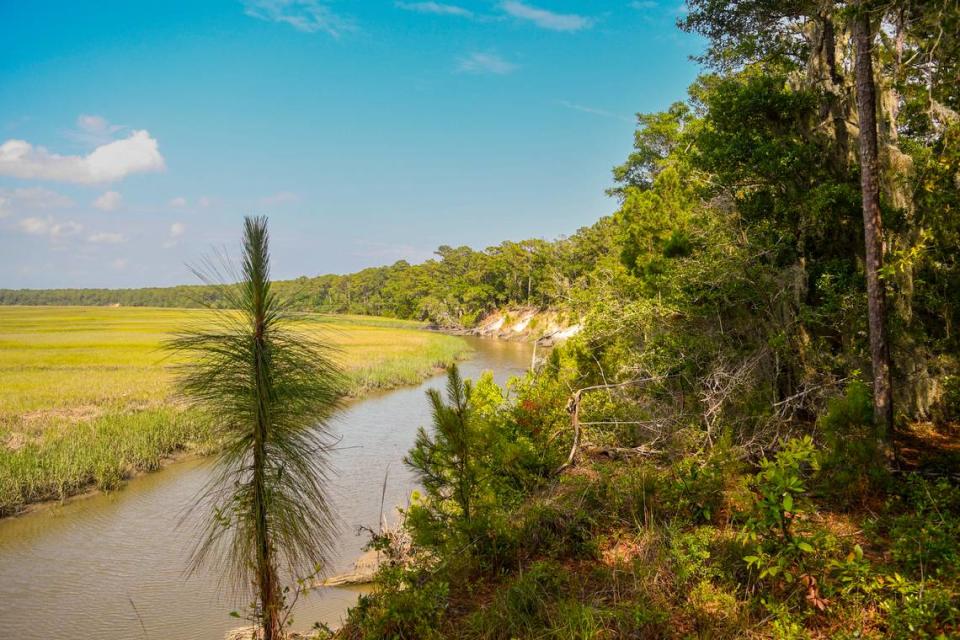Another set of losses for Pine Island Developer after Planning Commission meeting
Applause rang out from the mass of people wearing green “Protect St. Helena” stickers as the Beaufort County Planning Commission recommended against removing Pine Island Plantation from the Cultural Protection overlay and denied the developer’s appeal to construct three six-hole golf courses on the property.
The commission’s votes came after an hour of public comments and, at times, had the trappings of a courtroom drama with lawyers weighing in frequently.
Developer Elvio Tropeano took no victories away from Monday night’s meeting where he had four items up for discussion. The first was a request by Tropeano to remove the plantation from the Cultural Protection Overlay.
The CPO restricts development on St. Helena aiming to protect the Gullah Geechee culture by restricting gated communities, resorts and golf courses. But, these restrictions will continue through the regulatory process as the appeal must go through multiple bodies, before it can be ultimately decided by the county council.
Rezoning Request
For the first time since going public with his plan to build a golf course on St. Helena, developer Elvio Tropeano was given the podium for as long as he chose to speak.
“I am requesting that my property on Pine Island be removed from the CPO because it will actually achieve the goals for the original CPO and protect the natural and cultural resources found on St. Helena Island,” said Tropeano.
Tropeano’s Pine Island Golf Club plan would see the 503 acre plantation, that he purchased for $18 million, turned into a “minimalist” golf course where 80% of the property would be conserved including both cultural and historic areas, he said. Homes built on the plantation would be relegated to Pine Island itself.
His golf plan would create significantly less development than what is permitted for the plantation’ CPO. Tropeano is quick to remind opponents that if he can’t build a golf course he’s fully in his rights to create a 166 home and a 90-dock gated community on the property. The current zoning, ‘T2 rural’ allows for one home per every three acres.
“I’ve taken the necessary steps to maximize the return on my investment,” said Tropeano. “The ramifications of this option are significant. It will add 500 new residents, that’s synonymous with rapid in-migration. It’ll add over 100 kids to the school system. It will change the voting dynamics for the entire area. And it may likely increase property taxes across St. Helena. And it may actually incentivize other people that own waterfront property to compete against me.”
“These aren’t threats, these are options,” He added. “I’m searching for a way to work within the system, but I need everyone to recognize that we have to do this together, not screaming and yelling at each other.”
Nearly 40 people signed up to speak during public comment. The majority of them against Tropeano and the Pine Island Golf Club.
Opponents of Tropeano’s plan also argued that allowing Pine Island outside of the CPO will create a slippery slope of future development.
“Our rules exist for a reason and the St. Helena community has worked diligently to defend the CPO’s long standing protection for their island that prohibit golf resorts and gated developments, said Jessie White, South Coast Office Director for the Coastal Conservation League. “The requests for special carve out to build is precisely what is not allowed (and) is an insult.”
“We are very educated people with our own plan for our legacy and generational wealth.” said Marie Gibbes.”We don’t need to be saved, we don’t need a savior.”
After an hour of public comments, the commission recommended that the county council should deny Tropeano’s zoning change request.
The Appeals
The remaining three items from Tropeano were appeals of denied plans for three six-hole golf courses on the island. Each course, being on separate lots were considered separate items, but were voted on and discussed as one.
The appeals process involved the planning commission hearing arguments from Tropeano’s lawyer and the county’s lawyer on why the denied request should be overturned or upheld.
The primary argument resides in what the CPO allows or does not allow regarding golf courses. The argument Tropeano is making centers on whether the county correctly or incorrectly used the ‘pending ordinance doctrine.’ Essentially, under law, a future land use ordinance that is already in the pipeline can be applied to a current application. Tropeano’s team is arguing that the county is in the process of changing the rules while it was reviewing his applications.
The CPO says that golf courses are incompatible with the CPO. The official wording, until recently, was as follows:
“Golf Course This includes regulation and par three golf courses having nine or more holes.”
Tropeano’s lawyer, Ellis Lesemann argued that under that ruling any golf course less than nine holes is allowed because it was not explicitly disallowed. Lesemann went on to argue that Assistant County Administrator for Planning and Zoning Rob Merchant put off doing anything with the application until after county council held the first reading of the CPO changes so that the county could use the ‘pending ordinance doctrine’ to deny the request for three six-hole golf courses.
“You can’t move the goal post and can’t shelve an application after its been submitted when it applies with the existing ordinance,” Lesemann said. “That’s an illegal act and that’s why the planning commission should reverse it.”
The CPO changes in question changed the definition of golf courses in the codes to the following:
“An area of land with improvements to the grounds on which the sport of golf is played. It typically consists of a series of holes, each consisting of a tee box, a fairway, the rough and other hazards, and/or a green with a cylindrical hole in the ground, known as a cup. Golf course accessory uses may include a clubhouse, restrooms, driving range, and shelters.”
Lesemann also pointed to comments from County Administrator Eric Greenway, who said in January that golf courses of less than nine holes were allowed under the then current ordinances.
“The issue is that the current overlay allows for an 8 hole golf course,” said Greenway on January 5. “A developer theoretically could come in and build two eight-hole golf courses on the same property and then a third two-hole golf course, if you can have eight holes.”
Lesemann argued this was an admission that the three six-hole courses were allowed under the CPO at the time of application.
Lesemann made a connection to a case on Hilton Head Island where indoor go-karts were explicitly not allowed. It was successfully argued that because the code did not also explicitly prohibit outdoor go-karts that they were allowed.
That argument resulted in the go-kart track at Broad Creek Marina.
However, Greenway’s role is to provide advice to the commission. What he says may not reflect a court’s interpretation of the law.
Deputy County attorney Brian Hulbert argued that the CPO had always prohibited any golf course regardless of how many holes. He presented a series of definitions from multiple dictionaries both modern and dating as far back as the 70s showing that the definition for golf and golf courses always read in a near identical manner to that of the old CPO’s definition.
Thus, he argued, Tropeano never had vested rights, or a right to develop after a significant investment to be code compliant, because the three courses were never allowed and so the ‘pending ordinance doctrine’ couldn’t apply. He also made the argument that vested rights only apply to final development plans and Tropeano’s plans never made it past the conceptual stage.
“The money spent by the application was with the knowledge that a golf course and resort were prohibited in the CPO standard,” Hulbert said. “Any money he invested and spent there he did with the knowledge that it wasn’t a permitted use.”
As final rebuttal, Leseman asked why the county would need to strengthen the CPO if it was already clear that all golf courses were prohibited.
“Is the county council in the process of doing unnecessary things so they have to go in and clarify ordinances that are very clear?” asked Lesemann.
After a 30 minute executive session, which was followed by nearly an hour of questions from the commission and subsequent discussion, the commission unanimously voted to deny the appeal for the three golf courses.
Now what?
Tropeano’s rezoning request to have his property removed from the CPO will continue to move through the county’s process. After a recommendation from the Community Services and Land Use Committee, the request will go to county council.
The full council can decide to remove the property from the CPO, regardless of recommendations from the planning commission and the committee. If the request gets six votes after three readings Pine Island Plantation will be removed from the CPO.
Another avenue would be to take the issues of fairness and legality presented last night to the courts. “It’s always possible,” Lesemann, Tropeano’s attorney said.
Tropeano’s biggest hurdle with the project is with the public reception of his plan. People continue to gather in large numbers to voice their opposition to developing Pine Island, but Lesemann says a court would be less swayed by public opinion.
“When you’re in front of a municipal body, a lot of times the outcome is very swayed by emotion and by sentiments,” Lesemann told the Island Packet / Beaufort Gazette Tuesday morning. “But when you get into the realm of the law and a legal proceeding, the rights as the law recognizes, are upheld without regard to emotion, or to ignoring the rights of one to focus entirely upon the rights of another.”
“The courts are guided by law, not by sentiment,” he added.




